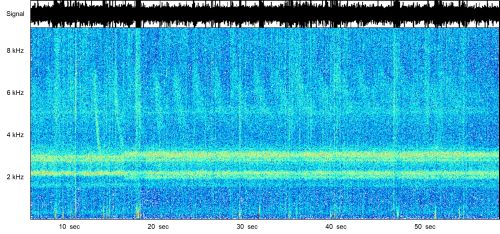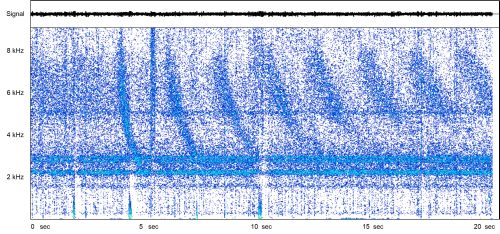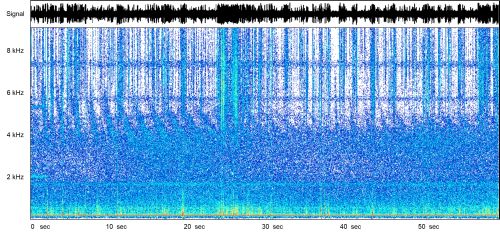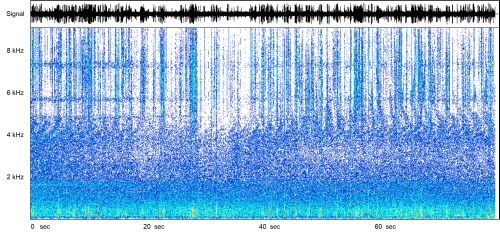Click on blue-rimmed images to enlarge.
Echo Trains on the Beach
After I had heard the first whistler one evening in 2004, the date of August 24th,
2005 is the next memorable day for me. At the beach on the Baltic Sea at dusk I heard some
faint swishing noises. I started recording, despite some troubles with the receiver which still
had some noise at fairly high pitch. Only when I analyzed the data at home much later, it became
apparent that these were not just single whistlers but echo trains, where the radio pulse hops
back and forth between the hemispheres several times. Each time it arrives in the northern
hemisphere, it is audible as a whistler.

This train has its origin in the sharp pulse just after the 10 sec mark. This shows that the
lightning discharge was somewhere in Europe. The first whistler arrives about 2.5 sec later
(at about 3 kHz), another one follows by another 2.5 sec ... in the end, one can
make out 18 whistler echos during 42 sec (between 14 and 56 sec). This means that
a whistler takes 2.3 sec to make two hops, i.e. the voyage to the other hemisphere
and back. Since the whistlers have made 2, 4, 6, etc hops, one calls this an even Echo Train.
Successive echos have to pass again through the magnetospheric plasma twice, so they become
longer due to the larger dispersion. They also become progressively weaker. When you listen
to the sound, you will distinguish only the first few echos.
listen to the sound file
The high pitch whine at 2 and 3 kHz can be filtered out by software (e.g.
Audacity). The result is a bit more pleasant:

listen to the sound file
During that evening I made several recordings, of various quality. Another good and loud
echo train came just a few minutes later. Here the source spheric is not so clear, but
most probably it is the slight feature at 1.5 sec. One counts 7 whistlers within a time span
of 16 sec, which gives 2.3 sec per double hop.

listen to the sound file
Overlapping Trains
On Sept. 24th, 2006 I was at one of my favourite radio-quite spots.
At about CEST 14:00 there were some weak but promising noises, so I started recording.
Only the later analysis showed that there were several echo trains going on. At 14:05
it looked like this:

One counts perhaps 29 whistlers in 60 sec, or about 2 sec per double hop.
listen to the sound file
The weak but fairly regular emissions continued, and at CEST 14:08 the
echos seemed to fold back in frequency:

listen to the sound file
At CEST 14:09 this was even more prominent. Evidently this is an overlap with another train
that started at about 50 sec:

listen to the sound file
| Top of the Page | Back to the MainPage | to my JavaScript Tools | to my Java Applets | to my HomePage |
last update: Apr 2018 J.Köppen